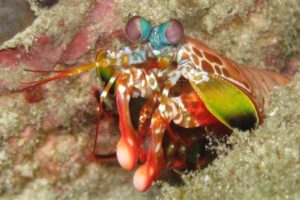
A peacock mantis shrimp is seen in the Andaman Sea off Thailand. The club-shaped “fingers” that the shrimp uses to crack shells of shellfish and kill prey are seen in front. The intricate design of those clubs served as partial inspiration for a materials breakthrough involving UT.
A team including researchers from UT, Harvard University, and the University of Pennsylvania has opened up new pathways to 3D print short-fiber-reinforced materials with precisely controlled fiber arrangements.
Currently, 3D printing methods for polymer composites build parts by extruding materials through a nozzle that simply moves back and forth in a series of lines to define the desired shape.
The team’s advance adds precisely controlled rotation of the nozzle to the mix to allow variation of the fiber arrangement throughout the printing process. The new process, called rotational 3D printing, results in unique helical fiber arrangements that provide superior damage resistance to printed materials.
In simple terms, carbon fibers adopt spiral patterns as they are printed within an epoxy resin, much as steel wires are bundled and twisted together into larger, stronger cables.
“Having the ability to change fiber orientation without changing the tool path used to deposit the material means that optimal or near-optimal fiber arrangements can be achieved at every location in the printed part, resulting in higher strength and stiffness with less material,” said Brett Compton, a co-author of the study and assistant professor of mechanical engineering at UT.
“The rotational print head is unique because it utilizes the viscosity of the ink itself to reorient fibers in a desirable way,” Compton said.
The team was led by Professor Jennifer Lewis at Harvard University and includes researchers from the University of Pennsylvania and ETH Zurich, a top research university in Switzerland.
Compton said the idea for such a design came from nature.
Helical arrangements of natural fibers are found in wood, antler, and bone, which are some of the strongest and toughest natural materials known.
A critical aspect of their work—the ability to control where the strongest and weakest points are located—was inspired by one of nature’s recent viral video stars, the mantis shrimp.
The shrimp, known as stomatopods, have a pair of clubbed “fingers” they accelerate so quickly that the bubbles they produce are powerful enough to crack crab, clam, and other shells.
While they must be strong enough to crack shells and provide the shrimp’s meals, the fingers must survive repeated use with minimal damage. Extreme impact resistance is achieved through variations in helical fiber arrangements that guide energy from impacts onto stronger regions of the club.
“Using that idea allows us to control how and where strain is distributed in printed components,” said Compton. “We can design fiber arrangements to protect certain regions or ensure that failure occurs only at desired locations.”
Compton said the concept of rotational 3D printing could be applied to any material system and any extrusion-based additive manufacturing technology, from the small-scale direct ink writing used in this study up to the large-scale BAAM 3D printers developed at Oak Ridge National Laboratory.
Compton initiated this work while he was a postdoctoral research fellow at Harvard’s Wyss Institute for Biologically Inspired Engineering. Co-author Jordan Raney began working with Compton there and is now an assistant professor of mechanical engineering and applied mechanics at the University of Pennsylvania.
Other team members are fellow Wyss Institute scientist Thomas Ober as well as Jochen Mueller and Professor Kristina Shea of ETH Zurich.
The work was published in the prestigious Proceedings of the National Academy of Sciences.
CONTACT:
David Goddard (865-974-0683, david.goddard@utk.edu)